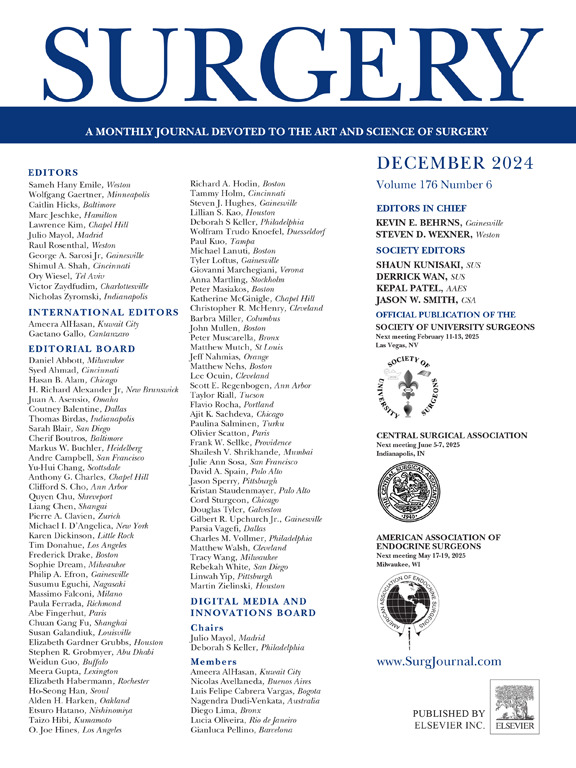A nomogram for predicting early biliary complications in adult liver recipients of deceased donor grafts: Integrating artery resistive index and clinical risk factors
IF 3.2
2区 医学
Q1 SURGERY
引用次数: 0
Abstract
Background
This study aimed to identify predictors of biliary complications within 90 days after liver transplantation in adult recipients of deceased donor grafts.
Methods
The study retrospectively analyzed adult patients who underwent liver transplantation from January 2016 to December 2021 using deceased donor grafts in our center. Patients were randomly divided into training and validation cohorts (7:3 ratio). A nomogram was developed using least absolute shrinkage and selection operator logistic regression for feature selection, followed by a 2-way stepwise approach in multivariate logistic regression. Model performance was assessed with the C-index, receiver operating characteristic area under the curve, calibration curves, and decision curve analysis.
Results
A total of 757 patients were included, of whom 76 developed early biliary complications. Least absolute shrinkage and selection operator binary logistic analysis showed that postoperative day 1 arterial resistance index, acute rejection, acute-on-chronic liver failure, hepatic artery thrombosis, recipient body mass index, and donor age were independent predictors of biliary complications within 90 days. A nomogram was established on the basis of these factors. The C-index for the final nomogram was 0.822. The area under the curve in the training cohort was 0.837 (95% confidence interval, 0.780–0.893) and 0.771 (95% confidence interval, 0.677–0.865) in the validation cohort. Calibration curves demonstrated good agreement between predicted and actual outcomes. Decision curve analysis confirmed the clinical utility of the nomogram.
Conclusion
Low arterial resistance index (≤0.57) on the first postoperative day is a predictor of biliary complications within 90 days after liver transplantation in adult recipients of deceased donor grafts. The nomogram provides a practical tool for predicting complications and guiding clinical decisions.

预测死亡供体肝移植成人早期胆道并发症的nomogram:动脉阻力指数与临床危险因素的整合
背景:本研究旨在确定成人死亡供体肝移植后90天内胆道并发症的预测因素。方法回顾性分析2016年1月至2021年12月在我中心接受肝移植的成人患者。患者随机分为训练组和验证组(7:3)。使用最小绝对收缩和选择算子逻辑回归进行特征选择,然后在多元逻辑回归中采用双向逐步方法开发了nomogram。采用c指数、受试者工作特征曲线下面积、校正曲线和决策曲线分析对模型性能进行评价。结果共纳入757例患者,其中76例出现早期胆道并发症。最小绝对收缩和选择操作者二元logistic分析显示,术后第1天动脉阻力指数、急性排斥反应、急性慢性肝衰竭、肝动脉血栓形成、受体体重指数和供体年龄是90天内胆道并发症的独立预测因子。在这些因素的基础上建立了一个nomogram。最终模态图的c指数为0.822。训练组曲线下面积为0.837(95%可信区间0.780-0.893),验证组曲线下面积为0.771(95%可信区间0.777 - 0.865)。校正曲线显示预测结果与实际结果吻合良好。决策曲线分析证实了nomogram的临床应用价值。结论术后第一天动脉阻力指数低(≤0.57)可预测成人死亡供体肝移植术后90天内胆道并发症的发生。图为预测并发症和指导临床决策提供了实用的工具。
本文章由计算机程序翻译,如有差异,请以英文原文为准。
求助全文
约1分钟内获得全文
求助全文
来源期刊

Surgery
医学-外科
CiteScore
5.40
自引率
5.30%
发文量
687
审稿时长
64 days
期刊介绍:
For 66 years, Surgery has published practical, authoritative information about procedures, clinical advances, and major trends shaping general surgery. Each issue features original scientific contributions and clinical reports. Peer-reviewed articles cover topics in oncology, trauma, gastrointestinal, vascular, and transplantation surgery. The journal also publishes papers from the meetings of its sponsoring societies, the Society of University Surgeons, the Central Surgical Association, and the American Association of Endocrine Surgeons.
 求助内容:
求助内容: 应助结果提醒方式:
应助结果提醒方式:


